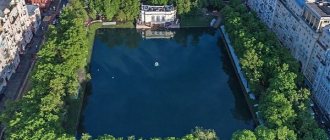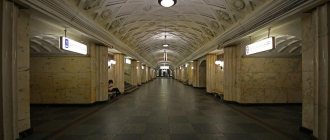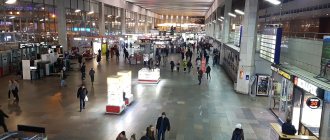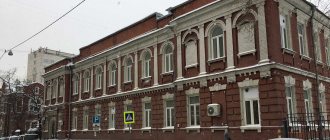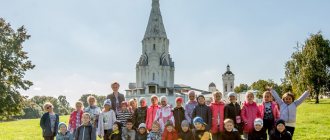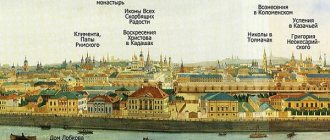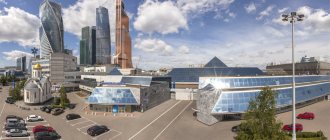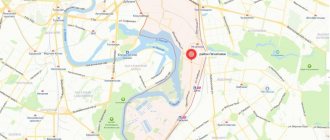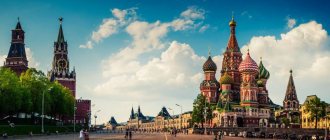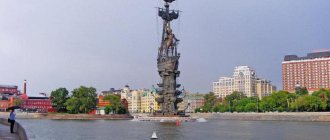Walk around Moscow: Chistye Prudy
A historical and, frankly speaking, atmospheric place for a walk in the center of Moscow is Chistye Prudy. The labyrinth of streets with ancient houses and signs on them with the names of people who were born, created masterpieces or simply stayed here for a while, form a kind of open-air museum. Everything here is so imbued with the spirit of history and creativity. Well, let's go ahead: we get to the Chistye Prudy metro station and here they are, protected spiritual places, stretching from Myasnitskaya to Pokrovskaya Square.
Moscow.org Moscow city portal
| All photos |
Chistoprudny Boulevard is one of 10 boulevards of the Boulevard Ring of Moscow, located in the Basmanny district of the Central Administrative District of the Russian capital. Despite its name, the Boulevard Ring is made in the shape of a horseshoe, i.e. it is not closed, but limited from the south by the Moscow River. Having emerged on the site of the dismantled wall of the White City, for several centuries now the Boulevard Ring has been delighting Muscovites and guests of the capital with beautiful landscapes and unique architectural monuments.
Chistoprudny Boulevard begins at Myasnitskie Gate Square, where houses are numbered, and ends at Pokrovskie Gate Square. This boulevard is the largest in area of all the boulevards of the Boulevard Ring in Moscow, but the second (after Tverskoy) in length. From the inside you can get to Chistoprudny Boulevard from Arkhangelsky Lane, and from the outside it is adjacent to Bolshoi Kharitonyevsky Lane and Makarenko Street.
The history of the origin of Chistoprudny Boulevard is one of the most interesting of all the stories of the origin of the boulevards of the Boulevard Ring in Moscow. The area where Chistoprudny Boulevard is located today has been known since the beginning of the 16th century, since at that time the Zhivotinny Dvor slaughterhouse was located here, later transformed into the Sovereign Battle Dvor. The brisk meat trade that took place nearby gave its name to Myasnitskaya Street adjacent to the boulevard. There was a swamp nearby, so all the meat slaughterhouse waste was dumped there; because of the dirt and foul smell, this body of water was called the Pogany Pond.
Since the area in the Chistye Prudy area lies on the top of a gentle hill, in such places there are often swamps from which small rivers originate. It was the same here. The Rachka stream flowed out of the pond (now it is in a collector) and flowed into the Moscow River on the south side. In 1699, Peter I’s favorite landowner A.D. Menshikov acquired a plot of land on Myasnitskaya Street. In the depths of the courtyard, he built the so-called Menshikov Tower, near which that same small pond was located. In 1710, on the initiative of the landowner, the meat trade on the street was curtailed, and a little later the slaughterhouse was moved to another location. The landowner ordered the pond to be cleared of dirt, in particular waste from the meat trade, and strictly forbade polluting it, so the pond soon began to be called Clean. The name Chistye Prudy began to be used, although in fact there is only one pond. After Menshikov’s death, his house changed several owners, and was subsequently transferred to the jurisdiction of the Moscow Post Office.
However, there is another version of the origin of the name Chistoprudny Boulevard. According to the book “On Muscovite Affairs”, written by Courlander J. Reitenfels, the name arose due to the fact that the infidel Balts worshiped their pagan gods on these ponds. Indeed, in pre-Petrine times, the word “filthy” was not used in the meaning of “dirty”, but was identified with the word pagan, since it came from the Latin “paganus” - “pagan”. The above-mentioned book tells that it was on Pogany Pond in Moscow that the Gentiles worshiped their gods. In addition, there is another equally interesting legend associated with the birth of Moscow. According to this version, on the site of the current Chistoprudny Boulevard there was a village that belonged to the boyar Stepan Kuchka. One day, Prince Yuri Dolgoruky, angry at the poor reception of the boyar, ordered him to be killed and his body thrown into the pond, from which the latter began to be called Pogany. It should be noted that these days the pond is fed with water from the city water supply, the pipe of which is located opposite house 12a.
A significant milestone in the history of the Boulevard Ring and all its boulevards was the fire in Moscow in 1812. This fire did not leave its mark on Chistoprudny Boulevard either. The remains of the White City wall were demolished, and two hotel buildings were built at the ends of the boulevard. It should be noted that the hotel building at the Pokrovsky Gate has survived to this day almost in its original form, but the hotel at the Myasnitsky Gate, unfortunately, has not survived. In its place, the Chistye Prudy metro station was opened.
The development of Chistoprudny Boulevard was finally formalized by the mid-19th century, when a clear distinction was drawn between its internal and external sides. Thus, the inner side of the boulevard was built up with two-story houses of the Moscow rich and government institutions, and the outer side with one-story houses of poorer people. At the end of the century, three- and four-story apartment buildings appeared on Chistoprudny Boulevard, which in the post-war period were built up to six or seven floors.
In 1959, at the very beginning of Chistoprudny Boulevard, a monument to A.S. was erected. Griboyedov, created by sculptor A.A. Manuilov. This place was not chosen by chance, because for quite a long time the writer lived in house No. 42 on Myasnitskaya Street. Another interesting fact is that on the site of the current monument to Griboyedov, there used to be a monument to the ideologist of Russian anarchism M. Bakunin, designed by the sculptor M. Kovalev. The abstract futuristic manner in which the pedestal was made began to scare off Muscovites, so it was quickly removed.
The architecture of Chistoprudny Boulevard in Moscow is very interesting. The corner three-story house No. 1 belonged to the merchant Gusyatnikov, after whom the neighboring lane was named. It housed a grocery store; the building survived the fire of 1812. Also at number 1 there is a two-story stone building with an ornament imitating stone carving. In house No. 1a on Chistoprudny Boulevard there was a shelter for elderly doctors, and the building was originally intended for a pharmaceutical society. On Chistoprudny Boulevard there was another shelter, the so-called “House of Charity for Honored Elderly Members of the Postal and Telegraph Society,” located in house No. 4. At number 3a there are two houses, both built at the end of the 19th century. The great Russian actress Glikeria Fedotova lived on the left.
On the even side of Chistoprudny Boulevard there is a complex of houses No. 2, which was built in 1858 for a postal carriage station. Later the house was transferred to the Moscow Telegraph. After the old main post office building (located on Myasnitskaya Street) was occupied by the stock exchange, the main part of the post office moved here. The adjacent building houses the post office's office premises and employees' apartments.
House No. 12a, built in 1927 for the Kozhsindicate according to the design of the architect A.P., attracts attention. Golubev and engineer E. Izrailovich. For its time, this six-story building (the seventh floor was completed in 1948) was very progressive; it was a building made of lightweight reinforced concrete structures. Subsequently, this building successively housed: the People's Commissariat of Light Industry, the Ministry of Grain Products, the Ministry of Procurement, and the All-Union Center for Cinema and Television for Children and Youth. However, the historical value of this place lies in the fact that previously there was a wooden building for the “Battle of Borodino” panorama, built according to the design of military engineer P.A. Vorontsova-Velyaminov. The opening of the panorama took place on August 29, 1912. Then the Borodino panorama was moved to Kutuzovsky Prospekt. House No. 13 is another pre-revolutionary building on Chistoprudny Boulevard, which is about 150 years old. During the Soviet period, the upper floors were completed. Also pre-revolutionary, building No. 15 (Eple apartment building) is distinguished by its ancient wall cladding with roughly cut stones on the outside.
A significant building is No. 19a, on Chistoprudny Boulevard. Today, the Sovremennik Theater is located here, although the building itself with a colonnade stylized as antiquity was built in 1912 as the Colosseum cinema. Building No. 21 preserves the memory of a lot of wonderful Russian writers, composers, and singers. From 1898 to 1904, the writer N.D. lived in the second floor apartment of this building. Teleshov, who initiated the organization of the literary circle Sreda, who moved to the neighboring house No. 23. In 1907, a private Modern library was opened in the lower floor of this house, later it was nationalized, and in 1921 renamed the library named after F.M. Dostoevsky. This house is associated with another famous family; the outstanding Soviet film director S. M. Eisenstein lived in apartment No. 2.
From Chistoprudny Boulevard in Moscow, the Church of the Archangel Gabriel, located in Arkhangelsky Lane, is clearly visible. The temple was built in 1705-1707 by order of A.D. Menshikov. According to legend, he ordered a new temple in the form of a high tower to be built on the site of the wooden church that stood here. Due to the appointment of Menshikov as governor of St. Petersburg, work on the church was never completed. Only in 1787 was it completed by the famous Moscow freemason G.Z. Izmailov, decorating it with Masonic symbols. In the mid-19th century, by order of Metropolitan Philaret, all Masonic images and inscriptions were destroyed. In April 2006, a monument to Abai Kunanbayev (sculptor M. Ainekov, architect V. Romanenko) appeared on Chistoprudny Boulevard in Moscow.
History of Chistye Prudy
There are several versions of the history of the emergence of Chistye Prudy. A more well-known version is that in the 17th century there was a slaughterhouse in this area, and sewage was discharged into local reservoirs; then there were three such ponds, called filthy. After the command of Peter I, these lands were granted to his favorite, Prince Menshikov. By order of the prince, some of the reservoirs were drained, and the largest of them was cleaned, while a ban on water pollution was imposed. From that moment on, Chistye Prudy became the historical name of the place, retaining the plural form in the name as a tribute to the past.
Today it is a walking area and a cultural and historical park. Chistoprudny Boulevard is a wide park alley for walking, which extends to the health center, and behind this building, to the Pokrovsky Gate Square, is the pond itself. You can rent a bicycle to tour nearby historical sites or walk along the pond, feed the ducks and admire the swans.
Notable buildings and structures
Chistoprudny Boulevard
House No. 14
Monument to Alexander Sergeevich Griboedov
On the odd side
- No. 1 - corner building - House of the merchant Gusyatnikov, after whom the neighboring Gusyatnikov Lane is named. The house survived the fire of 1812. The second house on the boulevard, under the same number, was built by B.V. Freidenberg in 1886;
- No. 1a - house of the Medical-Philanthropic Society with a shelter and a hall for public meetings (1908-1912, architect A.I. German). Reconstructed in the 1940s, it is a valuable city-forming object[3]. Literary critic D. D. Blagoy[4] and medievalist historian N.P. Gratsiansky[5] lived in the house;
- No. 3a - residential building (1880s, architect A.I. Gaudring; 1970s). Actress Glikeria Nikolaevna Fedotova lived here in 1917-1925. Now - the Embassy of Kazakhstan;
- No. 9 - post-constructivist residential building (1938-1941, architects M. S. Sherfetdinov, M. I. Pekarev[6].). Linguist R.I. Avanesov[7] and scientist in the field of continuum mechanics A.A. Ilyushin[8] lived here;
- No. 11 - a house built in the 19th century, completed in the 1930s from 4 to 6 floors[6];
- No. 11, p. 4 (in the courtyard) - a residential building with chambers of P.V. Makulov - M.Z. Shamzarov (1690s, 19th century, early 20th century). Here in the 1830-1840s. the sculptor I. P. Vitali lived and worked;
- No. 13 - house built in the 19th century, completed in the middle of the 20th century;
- No. 15, building 2 - Epple apartment building (1912, architect A. N. Zeligson);
- No. 17 (left building) - a mansion from the 1st third of the 19th century[6];
- No. 19a - the building of the Colosseum cinema (1912-1914, architect R.I. Klein)[6]. The theater operated under its original name until 1970. In the early 1970s, the building was reconstructed[9]. Since 1974, the Moscow Sovremennik Theater has been located here;
- No. 19/1 - apartment building (1890, architect A.V. Ivanov), built on during the Soviet years;
- No. 21 - apartment building (ca. 1900, architect V. N. Kardo-Sysoev). In this house, in the apartment of N.D. Teleshov, in 1898-1904, meetings of the literary circle “Sreda” were held, which collected the flower of Russian literature of that time. Since 1904, "Wednesdays" moved to the neighboring house No. 23;
- No. 23 - apartment building of N. D. Teleshov (1900, architect S. V. Barkov)[6]. Initially four-story, in 1947 it was expanded to 7 floors. The library named after F. M. Dostoevsky on the ground floor of the building has been operating since 1907. S. M. Eisenstein lived in apartment No. 2 from 1920 to 1934 (memorial plaque, 1958, sculptor A. N. Kostromitin)[10]. Actors Maxim Shtraukh[11], Judith Glizer[12] also lived in the house;
- No. 25/21 - residential building in Art Nouveau style (1901, architect P. A. Drittenpreis).
On the even side
- No. 2 - a complex of houses: on the corner there is a three-story postal carriage station of the Moscow Post Office (1858)[6], further along the boulevard there is a six-story house (1900, built on in 1952);
- No. 4 - “Care House for Honored Elderly Members of the Postal and Telegraph Department” (1898[6], architect A.P. Popov[13]);
- No. 6/19 - building of the Board of the Moscow-Kiev-Voronezh Railway (1891, architect D. N. Chichagov, rebuilt and added a 3rd floor in the 1910s by I. I. Rerberg). The house was based on the city estate of the Musins-Pushkins[14], 1810-1890. In 1925-1939, the house was occupied by the People's Commissariat for Education, where N.K. Krupskaya worked in the same years (memorial plaque on the facade);
- No. 8/12 - at the heart of the two-story building was the outbuilding of the estate of E. P. Kashkin - A. A. Durasova; the second floor appeared between 1802 and 1806. Restored in 1981-1982;
- No. 8, p. 1 - the main house of the Kashkin estate, was built in 1782-1784 after the demolition of the White City wall; its façade, recorded in Kazakov’s albums, had the characteristic appearance of early classicism. In 1950-1953 it was built from two to six floors[15]. The house housed the editorial offices of the newspapers “Working Moscow”, “Evening Moscow” and “Moskovskaya Pravda”[16], the publishing house “Moskovsky Rabochiy”, the editorial office of the almanac “Chimes”;
- No. 10 - outbuilding of the Kashkin estate (1876, architect A.E. Weber); A.E. Weber decorated the building with decor that has survived to this day;
- No. 10, p. 2 - Tupitsyn apartment building (late 18th century; 1817; 1859; 1875, architect A.E. Weber, from three to six floors it was added in 1940);
- No. 12 - complex of buildings:
- No. 12, building 1 - wellness club (former restaurant) “Chistye Prudy”;
- No. 12, p. 2 - residential building of the Military Builder cooperative (1931, architects K.V. Apollonov and N. Yakobson, engineer D. Behr)[17];
- No. 12, building 3 - residential building;
- No. 12, p. 4 - residential building of the Military Builder cooperative (1936, architect A.F. Volkhonsky)[6]. Many military personnel lived in this house, which explains the large number of people shot by the NKVD during the years of Stalin’s repressions. The database of the human rights society “Memorial” contains the names of 70 residents of this house who were shot during the years of terror[18]. The number of deaths in the Gulag camps has not been established. As part of the “Last Address” civil initiative, memorial signs with the names of the military man Stepan Nikolaevich Stepanov, industrial engineer Viktor Ivanovich Marasanov and music teacher Evgeny Borisovich Erenburg, who were shot by the NKVD in 1937-1938, were installed in the arch of the house of the Military Builder cooperative[19] ;
- No. 12, building 5 - residential building (1930);
- No. 12, building 7, 7a, architectural monument (regional) - the estate of S. I. Pashkov of the early 19th century. Here in 1811, a relative of the owners, poetess E. P. Rostopchina, was born. In 1831, the estate was visited by A. S. Pushkin and N. N. Goncharova, a cultural heritage site of regional significance[20]. The main house of the estate (page 7) was built by the Pashkov nobles in 1789-1792 along the line of modern Potapovsky Lane, in the future of modern Sverchkov Lane. Several outbuildings at different ends of the huge courtyard have also been preserved. In 1840, the Pashkovs sold the house to the treasury. In 1912, the first Panorama building “Battle of Borodino” was built in the southern part of the property (not preserved)[21]. The outbuilding (page 7A) is adjacent to the south wing of the main house. According to BTI data for 1987, the depreciation of the object was 74%. In 2001, the Moscow Government leased it to the Interregional public organization “Center for Russian-Uzbek Cultural Cooperation named after. Tamara Khanum." It was planned to resettle the residents and previous tenants and carry out restoration. However, due to the failure of the new tenant to comply with the terms of the contract, the resolution was canceled and the work begun was not completed. In 2012, Renaissance LLC received the outbuilding under the “Ruble per Meter” program, and a security obligation was issued. In November of the same year, the outbuilding burned. In 2014, the Moscow City Heritage Department issued permission to develop a restoration project (the subject of protection was determined in 2013). In 2015, the roof was dismantled and a city plan for the land plot was drawn up[22]. In the fall of 2015, due to improper use, through the arbitration court, the lease agreement with Renaissance LLC was terminated, the Moscow State Heritage Department sent a technical condition report to the City Property Department to re-involve the building in economic circulation. According to information at the end of 2021, the copyright holder has not been determined, the auction is tentatively scheduled for the 1st-2nd quarter of 2021[21].
- No. 12, p. 8 - State Reserve Pharmacy of the Moscow District Engineering Department (1880s)[23]
- No. 12A - building of the Kozhsindicate (1926-1928, architect A.P. Golubev, design engineer E. Izrailovich)[6]. An early all-reinforced concrete structure. In 1912-1918, on this site there was a temporary pavilion of the Borodino Panorama, built by the architect P. A. Vorontsov-Velyaminov[2] for the centenary of the Battle of Borodino (the dome structures were designed by the same engineer - E. Izrailovich)[24], and before that - a pond in the garden of the Pashkov estate[25]. In 1989, in the lower high floor of the building, under the auspices of director R. Bykov, the Rolan cinema was opened[24]. Currently, in addition to the cinema, the building houses the Federal Migration Service and the Nostalgie restaurant;
- No. 12A, p. 2, 2A - Service building (1927, architect B. Norman, 1950s, 1980s)[23]
- No. 14 - apartment building of the Trinity Church on Gryazekh (1908-1909) - a monument of late, “national” Art Nouveau. The house, designed by architects L. L. Kravetsky (plans) and P. K. Mikini (structural engineer), is decorated with fabulous animals by S. I. Vashkov[6]. The house was originally four floors, and in 1945[6] it was built up to its current 7 floors. The animals have mostly been preserved (see old and modern photos);
- No. 16/15 - the corner house of the early 20th century was also initially three-story, and in the middle of the century it was built up to five floors.
Cultural and historical places of Chistye Prudy Park
Let's walk through the most iconic places along the route beloved by tour guides. The beginning of the park area of Chistoprudny Boulevard begins at the monument to Griboyedov, the author of the classic work “Woe from Wit”. On the pedestal you can see a high relief depicting the heroes of the comedy. The monument was created by sculptor Apollo Manuylov and installed in 1959 on the site of an abstract sculpture of the Russian anarchist Mikhail Bunin. The latter was dismantled at the request of members of the public for the incomprehensible futuristic approach to its creation. Griboedov himself lived for some time on Myasnitskaya Street, in house number 42, where he completed a famous comedy and therefore the place was chosen logically.
A walk along Chistoprudny Boulevard, on the left side, will lead us to house 19. The historical building, created by the architect Roman Klein at the beginning of the twentieth century in the neoclassical style, was the premises of the previously famous cinema “Colosseum”. And in 1974, the building housed and now houses the Sovremennik Theater. One of the founders and first artistic director of the theater was Oleg Efremov, who largely determined the stylistic feature of the theater - talking to the audience about eternal truths in the language of modern art.
Moving along Chistoprudny towards the Pokrovsky Gate, which geographically completes the Chistye Prudy district, you can go to the Church of the Trinity on Gryazekh, which is located on Pokrovka Street. Next to it is another architectural masterpiece - a tenement house that previously belonged to the church, built at the beginning of the 20th century. Its design is curious: bas-reliefs on the levels from the 2nd to 4th floors depicting fantastic animals, birds and trees. The authors of the design are S. Vashkov and P. Mikini. Thanks to these images, the building received the name “House with Animals.” The upper floors were added in 1945, so the building appears fragmentarily unfinished. This house is partially visible in the film “The Meeting Place Cannot Be Changed.”
“House with Animals” is adjacent to the modern cinema “Rolan”, located in house No. 12. It bears the name of the talented actor Rolan Bykov. Previously, there was a “Borodino Panorama” here, now it has been moved to Kutuzovsky Prospekt.
Further along Chistoprudny we go to Arkhangelsky Lane, turning onto which we will see the Menshikov Tower. Alexander Menshikov, “the rootless darling of fortune,” ordered the construction of a huge stone temple near his farmstead on the site of a dilapidated church. The construction of this structure was carried out with the participation of Italian architects. The temple tower, built in the Baroque style, surpassed the bell tower of Ivan the Great in height. But the “semi-sovereign ruler,” as Pushkin called Menshikov, did not rest on this. Alexander Danilovich bought a chiming clock in London for a fabulous sum, which was installed on the temple. The clock chimed the hour, half hour and quarters - which was not the case on the Kremlin's Spasskaya Tower. The celebration was complete, but short-lived. Lightning cut down the spire, and the clock - its life was short-lived - was dismantled and taken to the Cannon Yard.
origin of name
A.D. Menshikov, who bought a plot of land on Myasnitskaya Street, in 1703 ordered the cleaning of a pond polluted by waste from the meat trade, which has since become known as Chisty
.
Chistye Prudy
has come into use , although there is currently only one pond.
Moscow local historian S.K. Romanyuk gives a plan of the supposed ponds near the White City Wall in 1754, on which three ponds are marked; in addition, he points out that the pond, called Poganym
, was located within the White City (closer to Potapovsky Lane), and this name is associated not with the condition of the pond, but with the name of the local area in which foreigners settled [1].
Modernity of Chistye Prudy Park
A walk along Chistoprudny Boulevard is not only about historical monuments and tribute to the past. This is an active recreation area that attracts different generations and representatives of cultures to the alleys. Representatives of the modern underground also like to gather here. “At Griboedov’s” is a favorite place for romantic meetings. Both native Muscovites and guests of the capital want to come here to see with their own eyes the scenes inspired by the touching melody performed by Igor Talkov, illustrations by masters of painting and works of art.
In such a whimsical and natural way, history and modernity are combined, the need for the spiritual and exquisite gastronomic, in a calm and eventful place - Moscow's Chistye Prudy Park.
